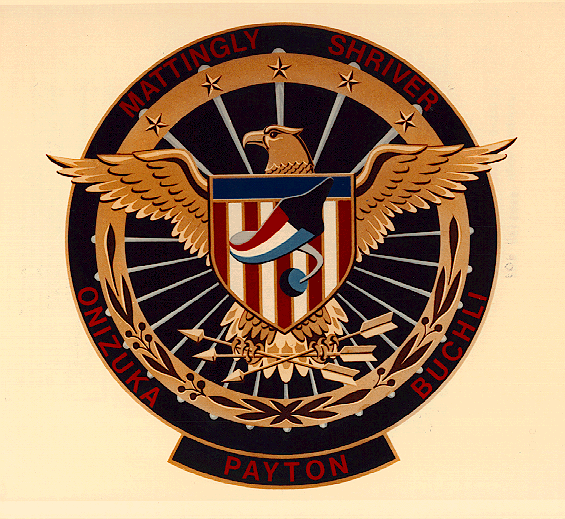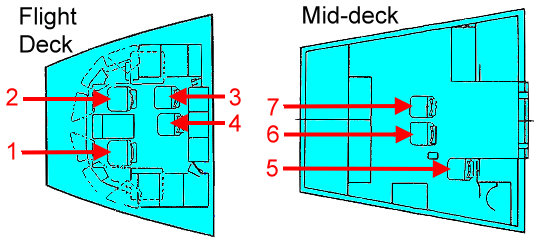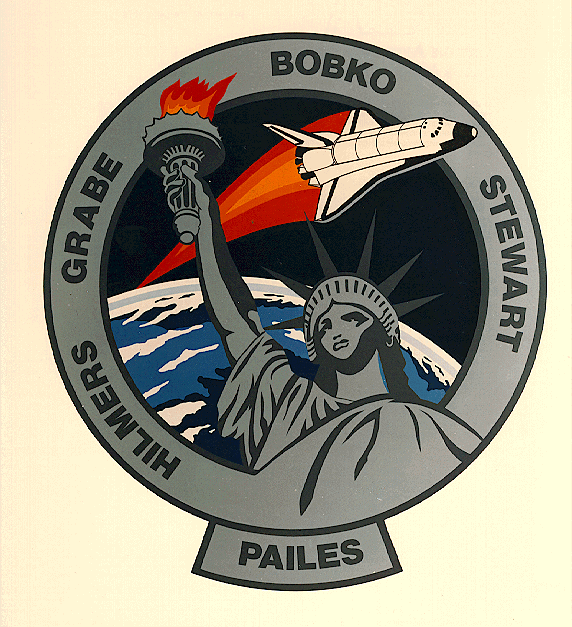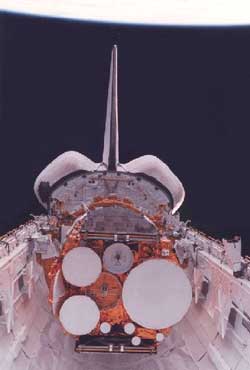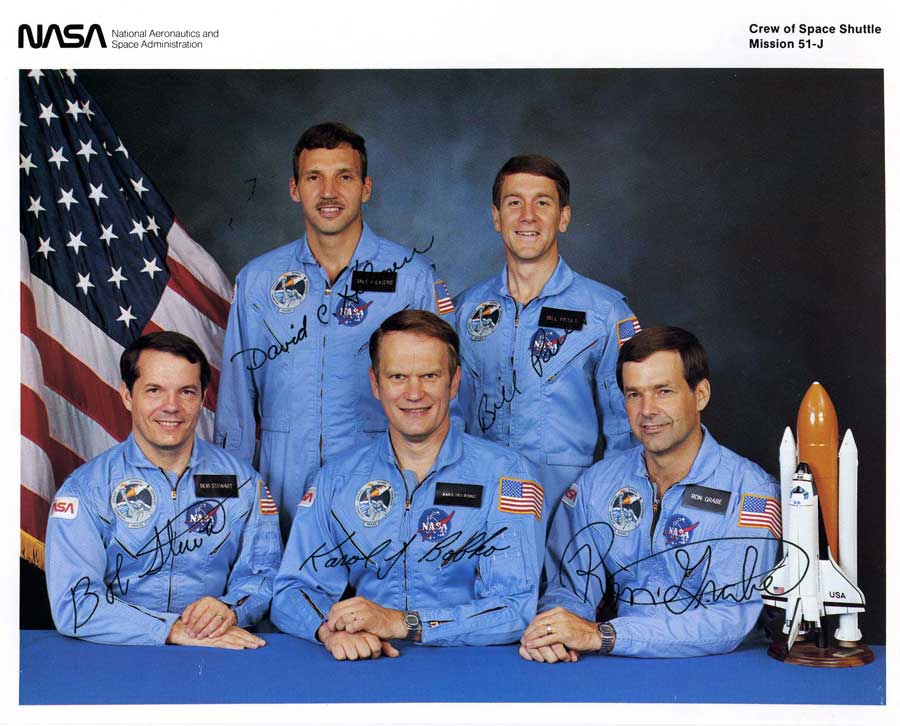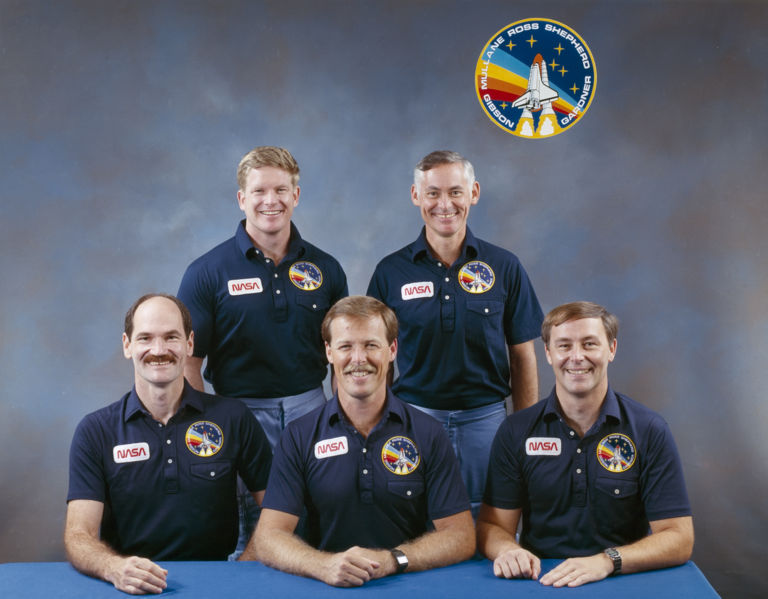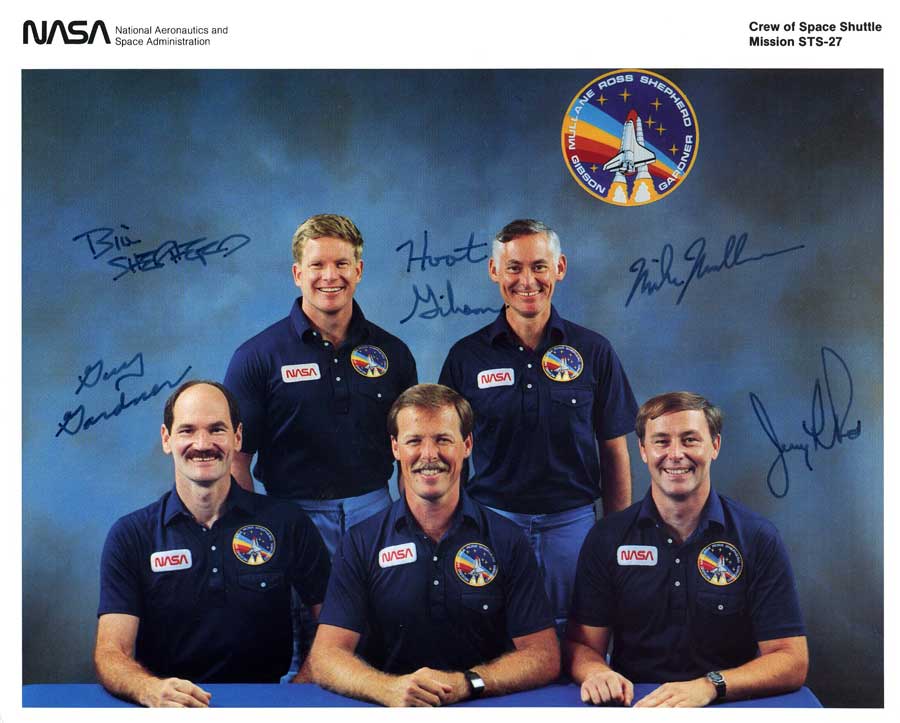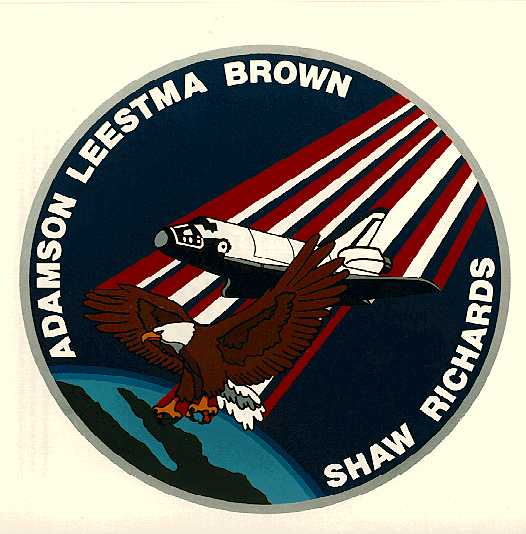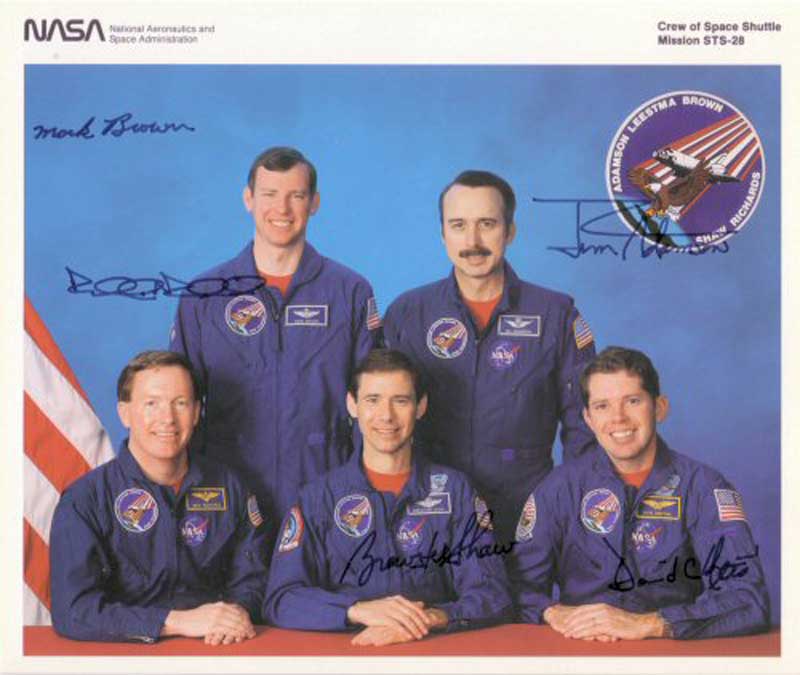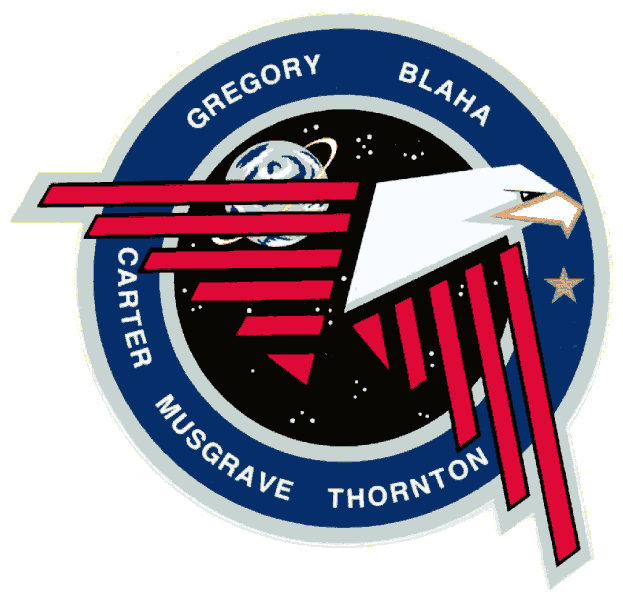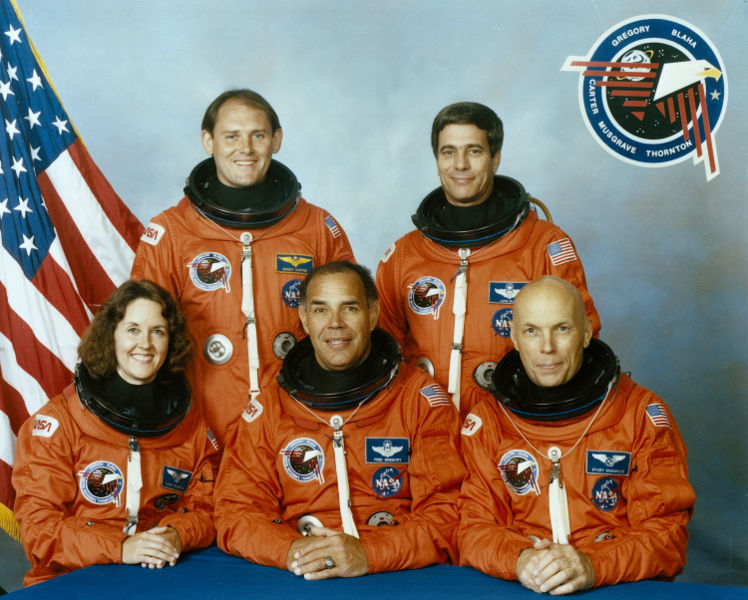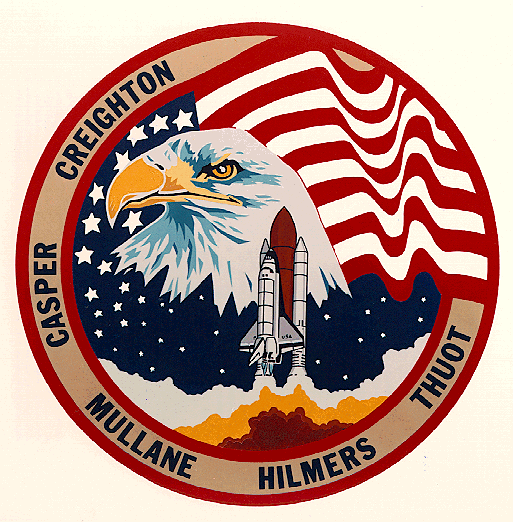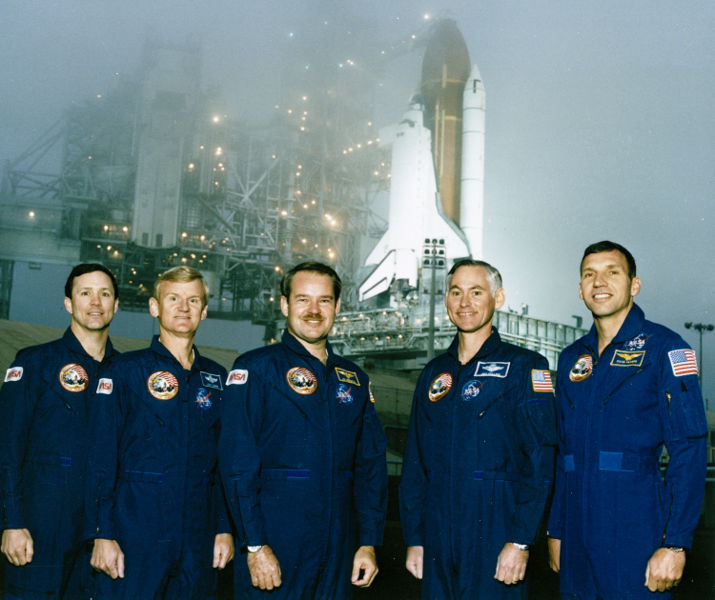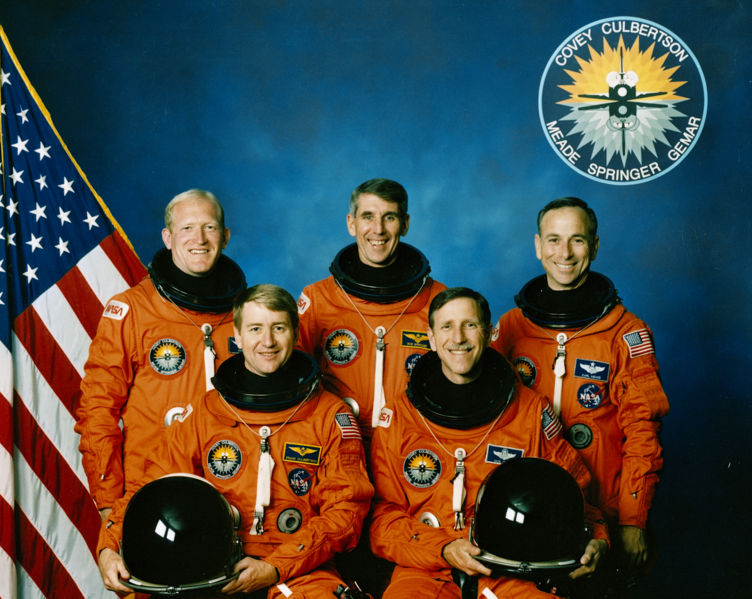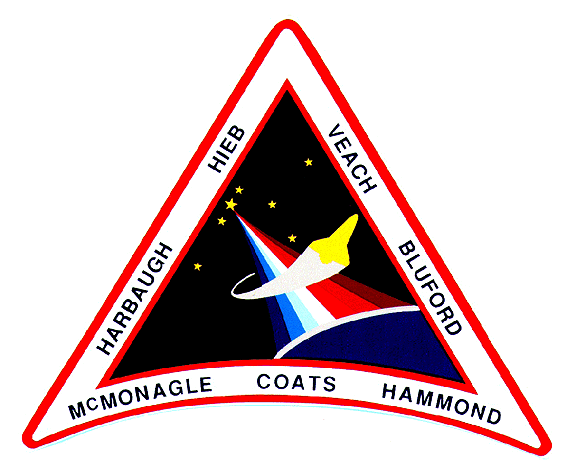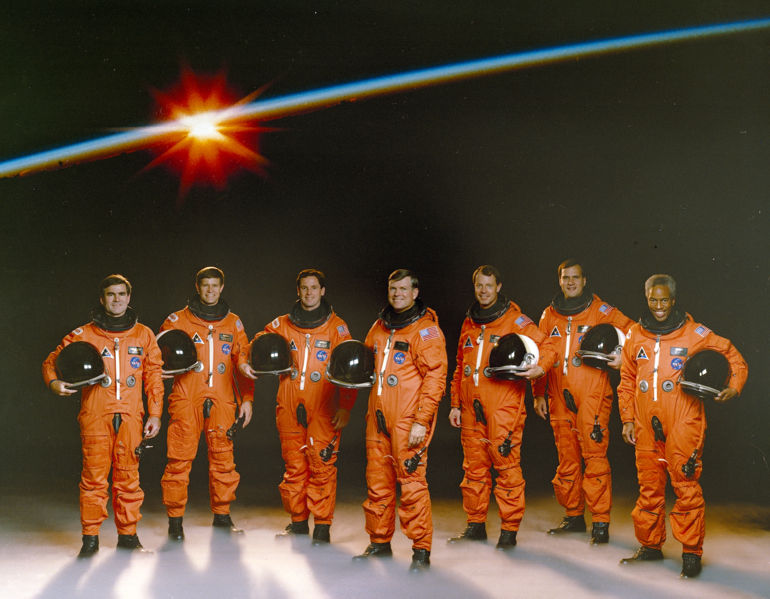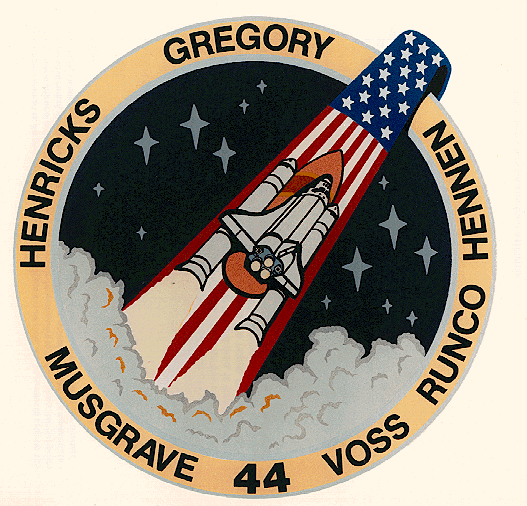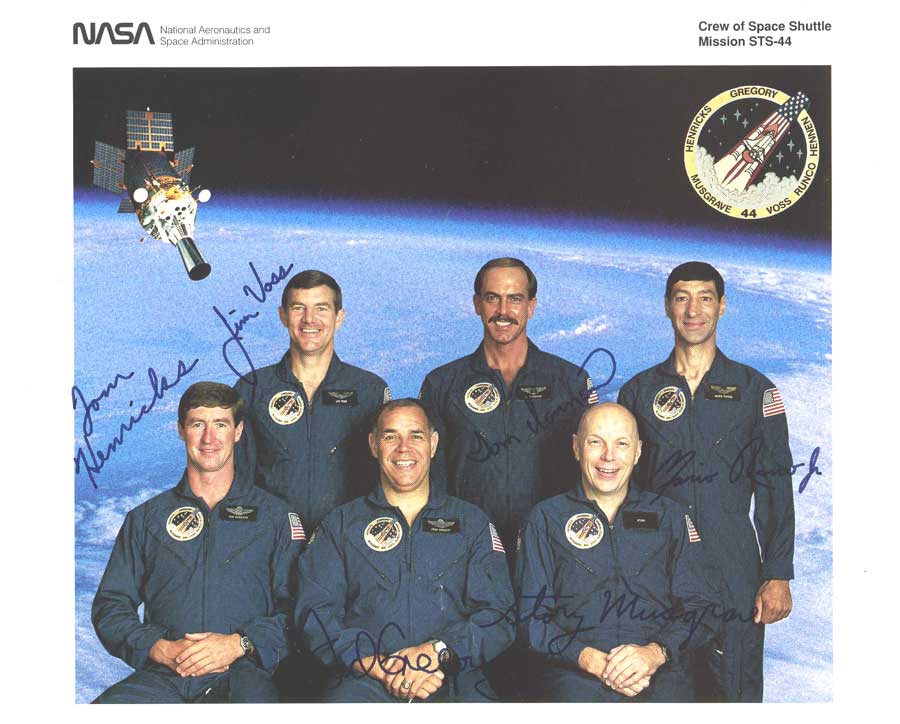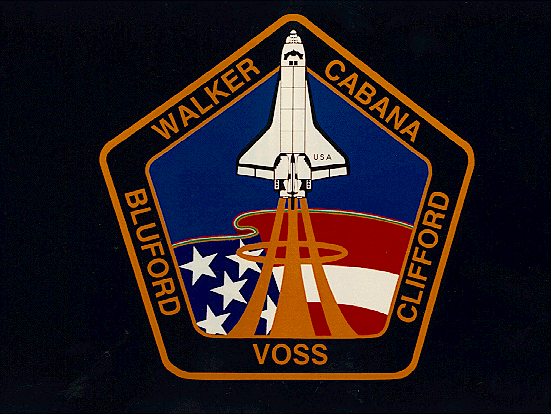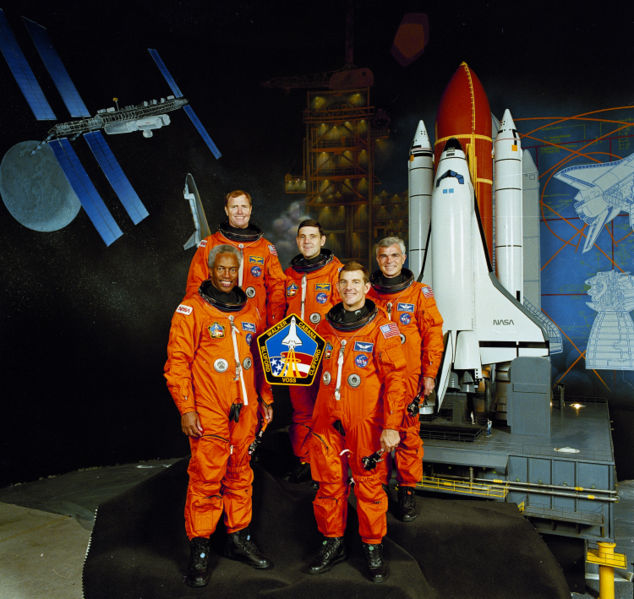|
Military Missions of the Space Shuttle |
|||||||||||||||||||||||||||||||||||||||||||||||||||||||||||||||||||||||||||||||||||||
 |
|||||||||||||||||||||||||||||||||||||||||||||||||||||||||||||||||||||||||||||||||||||
|
Department of Defense ..
The first military Shuttle mission was launched from Pad 39A at 1500Z on 27 June 1982. Military space missions also accounted for part or all of 14 out of 37 Shuttle flights launched from the Cape between August 1984 and July 1992. While many details of those missions are not releasable, some features of Shuttle payload ground processing operations and range support requirements can be summarized for what might be termed a "typical" military space mission. - SOURCE: Global Security A military space shuttle would have been the military equivalent of NASA's space shuttle. Many experts believe that it is extremely unlikely that NASA, the United States Department of Defense or any other Federal agency could keep the existence of such a spacecraft secret, given the official knowledge that stated extensive technical support and launching establishment would be necessary to fly it. It should however be noted that, early in the design phase of what eventually became the Space Shuttle, there were plans for the U.S. military to purchase some of the vehicles for its own purposes (mainly the servicing and crewing of proposed 'surveillance space stations'). The design requirements that thus emerged (in particular, the need for a longer-range glide capability, enabling the shuttle to land at specific U.S. Air Force bases), affected the eventual design of the vehicle, increasing its complexity. However, none of these 'Blue Shuttles' were ever built, and the U.S. military turned to increasingly sophisticated unmanned satellites as a more viable alternative. Regular space shuttles have on occasion carried out missions for the military. It is noteworthy that NASA and the DoD agreed on delivering Discovery to Vandenberg AFB, first in May 1985 and then in September of that year. Discovery would have been dedicated for military and civilian flights from Vandenbergs' SLC-6 launch complex. The schedule slipped until the Challenger Accident in January 1986. In the wake of Challenger, on December 26, 1989 the Space Shuttle Program at Vandenberg was terminated by the USAF. Military Shuttle flights were conducted from Kennedy Space Center in Florida, the last dedicated mission being STS-53 in late 1992, deploying a military SDS B-3 communication satellite. Some military payloads have been flown on regular civilian Shuttle missions afterwards. The Soviet Buran space shuttle was designed with military applications in mind as well. One of the main reasons for its creation was to counter the perceived military advantage that the NASA space shuttle gave the USA. On the first launch of Buran's energia booster the military Polyus satellite was launched. SOURCE: Wikipedia |
|||||||||||||||||||||||||||||||||||||||||||||||||||||||||||||||||||||||||||||||||||||
|
..
|
|||||||||||||||||||||||||||||||||||||||||||||||||||||||||||||||||||||||||||||||||||||
|
..
First mission dedicated to Department of Defense. U.S. Air Force Inertial Upper Stage (IUS) booster deployed and met mission objectives. This mission's accomplishments are classified due to the nature of the work done. The shuttle deployed a single satellite, 1985-010B (USA-8). According to Aviation Week, STS-51-C launched a secret, Magnum ELINT (ELectronic INTtelligence) gathering satellite into geosynchronous orbit. An identical one was also launched by STS-33 and STS-38. Also according to Aviation Week, the shuttle initially entered a 204 km x 519 km orbit at an inclination of 28.45 deg to the equator. It then executed three OMS (orbital maneuvering system) burns, the last on orbit #4. The first burn is to circularize the orbit at 519 km. The satellite was deployed on the 7th orbit and then ignited its IUS rocket at the ascending node of the 8th orbit, to place it in a geo-synchronous transfer orbit. The classified payload was deployed successfully and boosted into its operating orbit by an Inertial Upper Stage (IUS) booster according to an Air Force announcement. SOURCE: Wikipedia |
|||||||||||||||||||||||||||||||||||||||||||||||||||||||||||||||||||||||||||||||||||||
| STS-51C: Classified DoD Mission
Mission: Department of Defense
Crew Members
Image above: STS-51C Crew photo with Commander Thomas K. Mattingly, II, Pilot Loren J. Shriver, Mission Specialists Ellison S. Onizuka, James F. Buchli and Payload Specialist Gary E. Payton. Image Credit: NASA Launch Highlights STS-51C Mission Patch The launch scheduled for January 23 was scrubbed due to freezing weather conditions. (Orbiter Challenger was scheduled for Mission 51-C but thermal tile problems forced the substitution of Discovery.) The countdown phase was completed satisfactorily, however, two minor orbiter problems were noted during that period. The first occurred during the T-3 hour hold and involved a force fight in the right inboard elevon actuator between channel 4 and channels 1, 2, and 3. The condition corrected itself within 22 seconds after the Auxiliary Power Unit (APU) start up at T-5 minutes. A similar problem with the same channels in the same actuator occurred on STS 41-D (the first flight of this vehicle). The second problem that was noted during the countdown phase was the high helium concentration in the orbiter mid-body. A pressure decay test showed no significant system leakage. The high helium concentration disappeared when the main propulsion system (MPS) gaseous helium system was pressurized to the flight level. System operations were all nominal during the ascent phase. Solid rocket booster (SRB) motor performance was near the predicted levels and well within the allowed envelopes. The external tank and MPS performance was excellent with main engine cutoff (MECO) near the predicted time. At external tank separation, the backup flight system (BFS) did not automatically proceed to major mode 104. The crew performed the necessary manual procedures, and the BFS operated satisfactorily until the deorbit maneuver when the BFS time for deorbit maneuver ignition was 8 seconds late. However, the BFS operated satisfactorily for entry. Mission Highlights This was the first mission dedicated to the Department of Defense. The U.S. Air Force Inertial Upper Stage (IUS) booster was deployed and met the mission objectives. NASA's John F. Kennedy Space Center
|
|||||||||||||||||||||||||||||||||||||||||||||||||||||||||||||||||||||||||||||||||||||
Crew..
Crew seating arrangement
..
SOURCE: Spacefacts |
|||||||||||||||||||||||||||||||||||||||||||||||||||||||||||||||||||||||||||||||||||||
| STS 51C: Mission Summary
This was the first dedicated Department of Defense mission. Elements of the mission were kept secret. However, it was reported that a U.S. Air Force Inertial Upper Stage (IUS) booster successfully deployed a secret payload. |
|||||||||||||||||||||||||||||||||||||||||||||||||||||||||||||||||||||||||||||||||||||
| STS 51C: Mission highlights
First mission dedicated to Department of Defense. U.S. Air Force Inertial Upper Stage (IUS) booster deployed and met mission objectives. This mission's accomplishments are classified due to the nature of the work done. The shuttle deployed a single satellite, 1985-010B (USA-8). According to Aviation Week, STS-51-C launched a secret, Magnum ELINT (ELectronic INTtelligence) gathering satellite into geosynchronous orbit. An identical one was also launched by STS-33 and STS-38. Also according to Aviation Week, the shuttle initially entered a 204 km x 519 km orbit at an inclination of 28.45 deg to the equator. It then executed three OMS (orbital maneuvering system) burns, the last on orbit #4. The first burn is to circularize the orbit at 519 km. The satellite was deployed on the 7th orbit and then ignited its IUS rocket at the ascending node of the 8th orbit, to place it in a geo-synchronous transfer orbit. The classified payload was deployed successfully and boosted into its operating orbit by an Inertial Upper Stage (IUS) booster according to an Air Force announcement. SOURCE: Wikipedia |
|||||||||||||||||||||||||||||||||||||||||||||||||||||||||||||||||||||||||||||||||||||
|
..
First flight of Space Shuttle Atlantis. First Department of Defense Space Shuttle flight in which the payload, orbital parameters and mission objectives remain classified. An Air Force crew flew the highly successful mission. Landed at Edwards Air Force Base, CA at 1:00 PM EDT on October 7. Flight duration was four days, one hour and 45 minutes. This was the second Space Shuttle mission totally dedicated to the Department of Defense. Its cargo was classified but it is reported that two (USA-11 and USA-12) DSCS-III (Defense Satellite Communications System) communications satellites were launched into stationary orbit by an Inertial Upper Stage. The DSCS satellites use X-band frequencies (8/7 GHz). Each DSCS III satellite has a design life of ten years, although several of the DSCS satellites on-orbit today have far exceeded their design life expectancy and continue to perform with outstanding results. Liftoff occurred on October 3, 1985, at 11:15 a.m. EDT, from Pad A, Launch Complex 39, Kennedy Space Center. The orbiter was Atlantis, making its first flight. The mission was classified as "Successful." After a duration of 4 days, 1 hour and 45 minutes, Atlantis landed on Runway 23 at Edwards AFB at 1:00 p.m. EDT on October 7, 1985. SOURCE: Wikipedia
space shuttle Atlantis' cargo bay before deployment in 1985. Photo: U.S. Air Force/NASA |
|||||||||||||||||||||||||||||||||||||||||||||||||||||||||||||||||||||||||||||||||||||
| STS-51J: Classified DoD Mission
Mission: Department of Defense
Crew Members
Image above: STS-51J Crew photo with Commander Karol J. Bobko, Pilot Ronald J. Grabe, Mission Specialists David C. Hilmers, Robert L. Stewart and William A. Pailes. Image Credit: NASA Mission Highlights
The launch was delayed 22 minutes, 30 seconds due to a main engine liquid hydrogen prevalve close remote power controller showing a faulty 'on' indication. This was the second mission dedicated to the Department of Defense. NASA's John F. Kennedy Space Center
|
|||||||||||||||||||||||||||||||||||||||||||||||||||||||||||||||||||||||||||||||||||||
|
..
Mission name: STS-27
Crew
STS-27 was a space shuttle mission by NASA using the Space Shuttle Atlantis. It was the 27th shuttle mission, and the 3rd for Atlantis, 2nd after the Challenger disaster. It carried a payload for the U.S. Department of Defense. Mission highlights The Space Shuttle Atlantis (OV-104), at the time the youngest in NASA's fleet, made its third flight in a classified mission for the Department of Defense(DoD). It deployed a single satellite, USA-34, which is widely believed to be the first of the Lacrosse radar imaging satellites. SOURCE: Wikipedia |
|||||||||||||||||||||||||||||||||||||||||||||||||||||||||||||||||||||||||||||||||||||
| STS-27: Classified DoD Mission
Mission: Department of Defense
Crew Members
Image above: STS-27 Crew photo with Commander Robert L.
Gibson, Pilot Guy S. Gardner, Mission Specialists Richard Mullane, Jerry
L. Ross and William M. Shepherd . Image Credit: NASA
Launch Highlights STS-27 Mission Patch The launch set for December 1 during a classified window lying within a launch period between 6:32 a.m. and 9:32 a.m., was postponed due to unacceptable cloud cover and wind conditions and reset for the same launch period on December 2. Mission Highlights Third mission dedicated to the Department of Defense. NASA's John F. Kennedy Space Center
|
|||||||||||||||||||||||||||||||||||||||||||||||||||||||||||||||||||||||||||||||||||||
|
..
STS-28 was the fourth shuttle mission dedicated to United States Department of Defense, and first flight of Columbia since mission STS-61-C. The details of the mission are classified. Mission statistics
Mission highlights Columbia deployed two satellites, 1989-061B (USA-40) and 1989-061C (USA-41). Early reports speculated that STS-28's primary payload was an Advanced KH-11 photo-reconnaissance satellite. Later reports and amateur satellite observations of the satellites suggest that USA-40 was a second-generation Satellite Data System relay like that launched on STS-53. SOURCE: Wikipedia |
|||||||||||||||||||||||||||||||||||||||||||||||||||||||||||||||||||||||||||||||||||||
| STS-28: Classified DoD Mission
Mission: Department of Defense
Crew Members
Image above: STS-28 Crew photo with Commander Brewster
H. Shaw, Pilot Richard N. Richards, Mission Specialists James C. Adamson,
David C. Leestma and Mark N. Brown. Image Credit: NASA
Launch Highlights **The launch set for December 1 during a classified window lying within a launch period between 6:32 a.m. and 9:32 a.m., was postponed due to unacceptable cloud cover and wind conditions and reset for the same launch period on December 2. Mission Highlights Fourth mission dedicated to the Department of Defense. (** PEGASUS NOTE: The Highligts are the same as posted foe STS-27 A typo?) NASA's John F. Kennedy Space Center
|
|||||||||||||||||||||||||||||||||||||||||||||||||||||||||||||||||||||||||||||||||||||
|
..
STS-33 was the fifth space shuttle mission for the Department
of Defense. Due to the nature of this mission, specific details are classified.
The Space Shuttle Discovery lifted of from Pad A, Launch Complex 39, KSC,
on 22 November 1989 at 7:23 p.m. EST.
Mission statistics
Mission highlights Discovery deployed a single satellite, USA-48 (NSSDC ID 1989-090B). According to Aviation Week, this was a secret Magnum ELINT (ELectronic INTtelligence) gathering satellite headed for geosynchronous orbit, like those launched by STS-51-C and STS-38. Also according to Aviation Week, the shuttle initially enters a 204 km x 519 km orbit at an inclination of 28.45 deg to the equator. It then executes three OMS (orbital manoeuvering system) burns, the last on orbit #4. The first burn is to circularize the orbit at 519 km. The satellite was deployed on the 7th orbit and then ignited its IUS rocket at the ascending node of the 8th orbit, to place it in a geo-synchronous transfer orbit. The classified payload was deployed successfully and boosted into its operating orbit by an Inertial Upper Stage (IUS) booster according to an Air Force announcement. Discovery landed on a concrete runway at Edwards AFB, CA, on November 27 at 7:30 p.m. EST, after a mission duration of 5 days, 0 hours and 6 minutes. Note: STS-33 was the original designation for the mission that became STS-51-L, Challenger’s last flight that ended in tragedy. After the disaster, NASA recycled the numbering system back to STS-26, which was the 26th shuttle mission and first after Challenger. There is no connection between Challenger’s STS-33 and this STS-33. SOURCE: Wikipedia |
|||||||||||||||||||||||||||||||||||||||||||||||||||||||||||||||||||||||||||||||||||||
| STS-33: Classified DoD Mission
Mission: Department of Defense
Crew Members
Image above: STS-33 Crew photo with Commander Frederick
D. Gregory, Pilot John E. Blaha, Mission Specialists F. Story Musgrave,
Manley L. Carter, Jr. and Kathryn C. Thornton. Image Credit: NASA
Launch Highlights The launch set for November 20 was rescheduled to allow changeout of suspect integrated electronics assemblies on the twin solid rocket boosters. Mission Highlights Fifth mission dedicated to the Department of Defense. NASA's John F. Kennedy Space Center
|
|||||||||||||||||||||||||||||||||||||||||||||||||||||||||||||||||||||||||||||||||||||
|
..
STS-36 was a space shuttle mission by NASA using the Space Shuttle Atlantis. It was the 34th mission, and carried a payload for the U.S. Department of Defense (believed to have been a Misty reconnaissance satellite). It was the sixth flight for Atlantis, the fourth night launch of the program, and the second night launch since Shuttle flights resumed in 1988. Mission statistics
Mission highlights The sixth shuttle launch dedicated entirely to the Department of Defense, STS-36's payload is classified. STS-36 launched a single satellite, 1990-019B (USA-53), also described as AFP-731. Other objects (1990-019C-G) have appeared in orbit since its deployment. It has been reported that USA-53 was an Advanced KH-11 photo-reconnaissance satellite that used an all-digital imaging system to return pictures. The KH-11 series is a digital imaging photo- reconnaissance satellite with both visual and infrared sensors. USA-53, nicknamed "Misty", was tracked briefly by amateur satellite observers in October and November 1990. The launch trajectory was unique to this flight, and allowed the mission to reach an orbital inclination of 62°, the deployment orbit of its payload, while the normal maximum inclination for a shuttle flight is 57°. This so-called "dog-leg" trajectory saw Atlantis fly downrange on a normal launch azimuth, and then maneuver to a higher launch azimuth once out over the water. Although the maneuver resulted in a reduction of vehicle performance, it was the only way to reach the required deployment orbit from the Kennedy Space Center (originally, the flight had been slated to launch from Vandenberg Air Force Base in California, until the shuttle launch facilities there were mothballed in 1989). Flight rules that prohibit overflight of land were suspended, with the trajectory taking the vehicle over or near Cape Hatterras, Cape Cod, and parts of Canada. The payload was considered to be of importance to national security, hence the suspension of normal flight rules. SOURCE: Wikipedia |
|||||||||||||||||||||||||||||||||||||||||||||||||||||||||||||||||||||||||||||||||||||
| STS-36: Classified DoD Mission
Mission: Department of Defense
Crew Members
Image above: STS-36 Crew photo with Commander John O.
Creighton, Pilot John H. Casper, Mission Specialists Richard M. Mullane,
David C. Hilmers and Pierre J. Thuot. Image Credit: NASA
Launch Highlights The launch set for February 22 was postponed to February 23, February 24, and February 25 due to illness of the crew commander and weather conditions. It was the first time since Apollo 13 in 1970 that a manned space mission was affected by the illness of a crew member. The launch was set for February 25 and scrubbed due to a malfunction of a range safety computer. The launch was reset for February 26 and scrubbed again due to weather conditions (Note: external tank loaded only for launch attempts on February 25 and 26, and launch on February 28). The launch on February 28 was set for a classified window lying within a launch period extending from 12 midnight to 4 a.m. EST. Mission Highlights Sixth mission dedicated to the Department of Defense. NASA's John F. Kennedy Space Center
|
|||||||||||||||||||||||||||||||||||||||||||||||||||||||||||||||||||||||||||||||||||||
|
STS-36 - February 28, 1990 CODENAME: MISTY ..
1990 February 28 - USA 53 - Launch Site: Cape Canaveral. Launch Vehicle: Shuttle. Mass: 19,600 kg (43,200 lb). Perigee: 198 km (123 mi). Apogee: 207 km (128 mi). Inclination: 62.00 deg. Period: 88.60 min. Deployed from STS-36 February 28, 1990. Said to be designated 'Misty', and believed to be the first maneouvering stealth satellite. Barely visible, it was rediscovered by amateur observors in October 1990, with a ground track that repeated every nine days. It maneouvered again in early November 1990, changing its inclination by 1.2 degrees and entering a lower orbit with a three-day repeating ground track. Amateurs again found it in 1996 and 1997 in a 66.2 degree orbit with a 99.4 minute period. The decay date for the active satellite is believed to refer instead to debris; the actually satellite was probably deorbited after 1997, perhaps after USA 144 (Misty 2?) was put into operation. MISTY INFORMATION
|
|||||||||||||||||||||||||||||||||||||||||||||||||||||||||||||||||||||||||||||||||||||
| Bigelow Aerospace Connection
A patent recently issued to an upstart space entrepreneur could be another sign that stealth satellites are real —not vestiges of the previous millennium’s battles. In late 2004, right about the time that some U.S. lawmakers publicly unveiled a previously classified $9.5 billion program to build satellites that orbit the Earth undetected from the ground, Robert Bigelow, hotel entrepreneur and founder of Bigelow Aerospace, submitted a patent application for a satellite that proposed to do just that. Bigelow’s patent, filed in November 2004 and approved a year later, follows a dozen or so previously filed inventions back to the early 1960s. Each outlined methods that could reduce or eliminate the optical and radar signatures that could be used to track, identify and determine the orbital parameters of a satellite from the ground. If the essentials of an orbit are obtained — potentially by low-cost, easily obtainable methods and equipment — an opponent can either hide above-ground activities during the reconnaissance satellite’s pass or possibly target the space vehicle with anti-satellite weapons. By all indications, the U.S. has launched and operated at least two such satellites in the post-Cold War era for photo reconnaissance or signal intelligence, one in 1990 and the other in 1999. Bigelow’s invention, called an inflatable satellite bus, appears to be identical in construction to the company’s Genesis I spacecraft, which was launched July 12 by an ISC Kosmotras Dnepr rocket into a 550-kilometer near-circular orbit with 64-degree inclination. The patent reveals that the shell, or outer surface of the inflatable portion of the vehicle, “can have radar stealth capabilities. This could include using radar absorbing materials and/or geometrics to reflect radar waves at angles that make detection of the craft difficult.” The patent goes on to say that shell could be “colored as to make visual detection more difficult.” |
|||||||||||||||||||||||||||||||||||||||||||||||||||||||||||||||||||||||||||||||||||||
|
..
'Misty' is the code-name widely attributed to a stealthy imaging satellite launched by the space shuttle Atlantis in 1990. A US patent from Teledyne Industries details a method of suppressing the visibility of satellites by means of an inflatable, reflective ballon, which would be inflated in orbit, and pointed towards the earth to deflect radar, lasers and also to defeat optical searches. Due to the covert and highly secret nature of this programme, it's not known what technology is used to hide the satellites, but this is a credible scheme. SOURCE: Rocket Science |
|||||||||||||||||||||||||||||||||||||||||||||||||||||||||||||||||||||||||||||||||||||
| Satellite Signature Suppression
Shield
Publication number: US5345238
Abstract of US5345238 An inflatable shield for suppressing the characteristic radiation signature of a satellite is described. The shield is conical-shaped and made from a thin synthetic polymer film material coated with a radiation reflecting material, such as gold or aluminum. At least one subliming agent is contained within the shield to inflate the shield when exposed to heat. An ultraviolet curable slurry coats the inner walls of the shield and permanently hardens the shield upon exposure to ultraviolet radiation from a self-contained source. The shield optionally may include absorbing and desiccant agents to absorb unwanted gas and water and prevent interference with the primary mission of the satellite. Additional means may be included for moving and positioning the shield with respect to the satellite. |
|||||||||||||||||||||||||||||||||||||||||||||||||||||||||||||||||||||||||||||||||||||
|
..
STS-38 was a space shuttle mission by NASA using the Space Shuttle Atlantis. It was the 37th shuttle mission, and carried a classified payload for the U.S. Department of Defense. It was the 7th flight for Atlantis. Mission highlights During STS-38, Atlantis deployed USA-67 [1]. According to Aviation Week, this was a secret Magnum (satellite) ELINT (ELectronic INTtelligence) gathering satellite headed for geosynchronous orbit like those launched by STS-51-C and STS-33, launched to monitor the events during the first Gulf War in 1990. Also according to Aviation Week, the shuttle initially enters a 204 km x 519 km orbit at an inclination of 28.45° to the equator. It then executes three OMS (orbital manoeuvering system) burns, the last on orbit #4. The first burn is to circularize the orbit at 519 km. Later observers have speculated that USA-67 was instead a secret SDS-2 military communications satellite, like those deployed on STS-28 and STS-53.[2] [3] The satellite was deployed on the 7th orbit and then ignited its IUS rocket at the ascending node of the 8th orbit, to place it in a geo-synchronous transfer orbit. The classified payload was deployed successfully and boosted into its operating orbit by an Inertial Upper Stage (IUS) booster according to an Air Force announcement. SOURCE: Wikipedia |
|||||||||||||||||||||||||||||||||||||||||||||||||||||||||||||||||||||||||||||||||||||
| STS-38: Classified DoD Mission
Mission: Department of Defense
Crew Members
Image above: STS-38 Crew photo with Commander Richard
O. Covey, Pilot Frank L. Culbertson, Mission Specialists Robert C. Springer,
Carl J. Meade and Charles D. Gemar. Image Credit: NASA
Launch Highlights The launch was originally scheduled for July 1990. However, a liquid hydrogen leak found on the orbiter Columbia during the STS-35 countdown prompted three precautionary tanking tests on Atlantis at the pad on June 29, July 13 and July 25. Tests confirmed a hydrogen fuel leak on external tank side of external tank/orbiter 17-inch quick disconnect umbilical. This could not be repaired at the pad and Atlantis rolled back to the VAB on August 9, was demated and transferred to the OPF. During rollback, the vehicle parked outside the VAB about a day while COLUMBIA/STS-35 stack was transferred to the pad for launch. Outside, Atlantis suffered minor hail damage to tiles during a thunderstorm. After repairs were made in the OPF, Atlantis was transferred to the VAB for mating on October 2. During hoisting operations, a platform beam that should have been removed from aft compartment fell and caused minor damage which was repaired. Vehicle rolled out to Pad A on October 12. Fourth mini-tanking test performed October 24, with no excessive hydrogen or oxygen leakage detected. At Flight Readiness Review, launch date was set for November 9. Launch was reset for November 15 due to payload problems. Liftoff occurred during a classified launch window lying within a launch period extending from 6:30 to 10:30 p.m. EST, November 15, 1990. Mission Highlights Seventh mission dedicated to Department of Defense. NASA's John F. Kennedy Space Center
|
|||||||||||||||||||||||||||||||||||||||||||||||||||||||||||||||||||||||||||||||||||||
|
..
Mission statistics
Mission highlights Dedicated Department of Defense mission. Unclassified payload included Air Force Program-675 (AFP675); Infrared Background Signature Survey (IBSS) with Critical Ionization Velocity (CIV), Chemical Release Observation (CRO) and Shuttle Pallet Satellite-II (SPAS-II) experiments; and Space Test Payload-1 (STP-1). Classified payload consisted of Multi-Purpose Release Canister (MPEC). Also on board was Radiation Monitoring Equipment III (RME III) and Cloud Logic to Optimize Use of Defense Systems-IA (CLOUDS-I). STS-39 was the first unclassified Department of Defense
(DoD)-dedicated Space Shuttle mission. There had previously been seven
Shuttle missions dedicated to the DoD, but those were considered classified
and information about the operation or success of the payloads or experiments
was not released. For STS-39, only the payload in
the Multi-Purpose Experiment Canister (MPEC) was listed as classified.
The crew was divided into two teams for around-the-clock operations. Among other activities, the crew made observations of the atmosphere and gas releases, Discovery’s orbital environment, and firings of the orbiter's engines, in wavelengths ranging from infrared to far ultraviolet. As part of the sophisticated experiments, five spacecraft or satellites were deployed from the payload bay, and one was retrieved later during the mission. Carried in the orbiter's cargo bay were: Air Force Program-675 (AFP-675); Infrared Background Signature Survey (IBSS); Space Test Program-01 (STP-01); and the MPEC. Inside the crew cabin were the Cloud Logic to Optimize the Use of Defense Systems-1A (CLOUDS 1-A) experiment and the Radiation Monitoring Equipment-III (RME-III). The Remote Manipulator System arm in the payload bay was used to deploy the Shuttle Pallet Satellite-II (SPAS-II) on which the IBSS was mounted. Among other observations, the SPAS-II/IBSS watched Discovery as it performed some orbital maneuvers including the "Malarkey Milkshake."[1]. The deployment of IBSS was delayed a day, until Flight Day Four, to give priority to the completion of the CIRRIS (Cryogenic Infrared Radiance Instrumentation for Shuttle) experiment which was depleting its liquid helium coolant supply faster than expected while making observations of auroral and airglow emissions. As usual, crew members faced some unexpected challenges during the mission. After working only about four hours, two tape recorders could not be reactivated. The tape recorders were designed to record observations made by three instruments on AFP-675. In a complicated two-hour bypass repair operation, the astronauts had to route wires and attach a splice wire to a Ku-band antenna system so the data could be sent directly to a ground station. The high orbital inclination of the mission, 57 degrees with respect to the equator, allowed the crew to fly over most of Earth's large land masses and observe and record environmental resources and problem areas. May 6, 1991, 2:55:35 p.m. EDT, Runway 15, Kennedy Space Center, FL. Rollout distance: 9,235 ft, rollout time: 56 s. Landing diverted to KSC because of unacceptably high winds at planned landing site, Edwards. Landing weight: 211,512 lb (95,940 kg). SOURCE: Wikipedia |
|||||||||||||||||||||||||||||||||||||||||||||||||||||||||||||||||||||||||||||||||||||
| STS-39: The "Malarkey Milkshake"
From this position, the crew will remotely command the SPAS-II/IBSS to point its imaging systems at Discovery for the first plume observation. Once the experiments are properly trained on Discovery, one OMS engine will be fired for 20 seconds. The result of the burn will be to propel Discovery north, off of its previous orbital groundtrack, without changing the spacecraft's altitude. A burn with this lateral effect is known as "out-of-plane." In order to set up the next observation and remain aligned with the SPAS-II for precise rendezvous maneuvers, immediately following the burn, the crew will perform a "fast-flip" yaw maneuver, using RCS jets to turn Discovery's nose around 180 degrees to the south. A single-engine OMS braking burn will then be performed to stop Discovery's travel at a point less than a mile north of its previous groundtrack. Using RCS jets, the crew will return Discovery to its starting position, on its originalgroundtrack behind the SPAS-II. As Discovery drifts back to the starting point, a "fast-flip" reversal will turn the spacecraft's nose back to the north. This unique series of multiple OMS and RCS maneuvers has been dubbed the "Malarkey Milkshake" in recognition of John Malarkey, the JSC rendezvous guidance team leader who developed the back-and-forth sequence. SOURCE: NASA Press Kit |
|||||||||||||||||||||||||||||||||||||||||||||||||||||||||||||||||||||||||||||||||||||
| STS-39: Unclassified DOD Mission
Mission: Department of Defense,
AFP-675; IBSS; SPAS-II
Crew Members
Image above: STS-39 Crew photo with Commander Michael
L. Coats, Pilot L. Blaine Hammond, Mission Specialists Guion S. Bluford,
Gregory J. Harbaugh, Richard J. Hieb, Donald R. McMonagle and Charles L.
Veach. Image Credit: NASA
Launch Highlights The launch was originally scheduled for March 9, but during processing work at Pad A, significant cracks were found on all four lug hinges on the two external tank umbilical door drive mechanisms. NASA managers opted to roll back the vehicle to the VAB on March 7, and then to OPF for repair. Hinges were replaced with units taken from orbiter Columbia, and reinforced. Discovery returned to the pad on April 1, launch was re-set for April 23. The mission was again postponed when, during prelaunch external tank loading, a transducer on the high-pressure oxidizer turbopump for main engine number three showed readings out of specification. The transducer and its cable harness were replaced and tested. Launch was rescheduled for April 28. Mission Highlights Dedicated Department of Defense mission. An unclassified payload included Air Force Program-675 (AFP675); Infrared Background Signature Survey (IBSS) with Critical Ionization Velocity (CIV), Chemical Release Observation (CRO) and Shuttle Pallet Satellite-II (SPAS-II) experiments; and Space Test Payload-1 (STP-1). Classified payload consisted of Multi-Purpose Release Canister (MPEC). Also on board was Radiation Monitoring Equipment III (RME III) and Cloud Logic to Optimize Use of Defense Systems-IA (CLOUDS-I). NASA's John F. Kennedy Space Center
|
|||||||||||||||||||||||||||||||||||||||||||||||||||||||||||||||||||||||||||||||||||||
|
..
STS-44 was Space Transportation System (NASA Space Shuttle) mission, launched November 24, 1991. It was a U.S. Department of Defense space mission. Mission highlights Dedicated Department of Defense mission. Unclassified payload included Defense Support Program (DSP) satellite and attached Inertial Upper Stage (IUS), deployed on flight day one. Cargo bay and middeck payloads: Interim Operational Contamination Monitor(IOCM); Terra Scout; Military Man in Space (M88-1); Air Force Maui Optical System (AMOS); Cosmic Radiation Effects and Activation Monitor (CREAM); Shuttle Activation Monitor (SAM); Radiation Monitoring Equipment III (RME III); Visual Function Tester-1 (VFT-1); Ultraviolet Plume Instrument (UVPI). Bioreactor Flow and Particle Trajectory experiment; and Extended Duration Orbiter Medical Project, a series of investigations in support of Extended Duration Orbiter. SOURCE: Wikipedia
Image Description: STS-44 Defense Support Program (DSP) / Inertial Upper Stage (IUS) spacecraft, with forward airborne support equipment (ASE) payload retention latch actuator released (foreground), is raised to a 29 degree predeployment position by the ASE aft frame tilt actuator (AFTA) table in the payload bay (PLB) of Atlantis, Orbiter Vehicle (OV) 104. Underneath the DSP / IUS combination, the umbilical boom is connected to the IUS. DSP components include Infrared (IR) sensor (top), AR I, SHF Antenna, EHF Antenna, Link 2 High-Gain Antenna, star sensor, and stowed solar paddles (box-like structure around the base). The Earth's limb and the blackness of space create the backdrop for this deployment scene. SOURCE: NIX
NASA JSC
|
|||||||||||||||||||||||||||||||||||||||||||||||||||||||||||||||||||||||||||||||||||||
| STS-44: Unclassified DOD Mission
Mission: DOD; DSP
Crew Members
Image above: STS-44 Crew photo with Commander Frederick
D. Gregory, Pilot Terence T. Henricks, Mission Specialists Mario Runco,
Jr., James F. Voss, F. Story Musgrave and Thomas J. Hennen. Image Credit:
NASA
Launch Highlights The launch set for November 19 was delayed due to a malfunctioning redundant inertial measurement unit on the Inertial Upper Stage booster attached to the Defense Support Program satellite. The unit was replaced and tested. The launch was reset for November 24, delayed 13 minutes to allow an orbiting spacecraft to pass and allow external tank liquid oxygen replenishment after minor repairs to the valve in the liquid oxygen replenishment system in the mobile launcher platform. Mission Highlights A dedicated Department of Defense mission. The unclassified payload included a Defense Support Program (DSP) satellite and attached Inertial Upper Stage (IUS), which were deployed on flight day one. Cargo bay and middeck payloads: Interim Operational Contamination Monitor (IOCM); Terra Scout; Military Man in Space (M88-1); Air Force Maui Optical System (AMOS); Cosmic Radiation Effects and Activation Monitor (CREAM); Shuttle Activation Monitor (SAM); Radiation Monitoring Equipment III (RME III); Visual Function Tester-1 (VFT-1); Ultraviolet Plume Instrument (UVPI). Bioreactor Flow and Particle Trajectory experiment; and Extended Duration Orbiter Medical Project, a series of investigations in support of Extended Duration Orbiter. NASA's John F. Kennedy Space Center
|
|||||||||||||||||||||||||||||||||||||||||||||||||||||||||||||||||||||||||||||||||||||
|
..
STS-53 was a Space Transportation System (NASA Space Shuttle) mission, launched December 2, 1992. Mission statistics
Mission highlights Discovery carried a classified primary payload for the United States Department of Defense, two unclassified secondary payloads and nine unclassified middeck experiments. Discovery's primary payload, USA-89 NSSDC ID 1992-086B is also known as "DoD-1", and was the shuttle's last major payload for the Department of Defense. The satellite was the second launch of a Satellite Data System-2 military communications satellite, after USA-40 on STS-28. Secondary payloads contained in or attached to Get Away Special (GAS) hardware in the cargo bay included the Orbital Debris Radar Calibration Spheres (ODERACS) the combined Shuttle Glow Experiment/Cryogenic Heat Pipe Experiment (GCP). Middeck experiments included Microcapsules in Space (MIS-l); Space Tissue Loss (STL); Visual Function Tester (VFT-2); Cosmic Radiation Effects and Activation Monitor (CREAM); Radiation Monitoring Equipment (RME-III); Fluid Acquisition and Resupply Experiment (FARE); Hand-held, Earth-oriented, Real-time, Cooperative, User-friendly, Location-targeting and Environmental System (HERCULES); Battlefield Laser Acquisition Sensor Test (BLAST); and the Cloud Logic to Optimize Use of Defense Systems (CLOUDS). SOURCE: Wikipedia |
|||||||||||||||||||||||||||||||||||||||||||||||||||||||||||||||||||||||||||||||||||||
| STS-53: Classified DoD Mission
Mission: DOD; ODERACS
Crew Members
Image above: STS-53 Crew photo with Commander David M.
Walker, Pilot Robert D. Cabana, Mission Specialists Guion S. Bluford, Jr.,
James S. Voss and Michael R. Clifford. Image Credit: NASA
Mission Highlights A classified Department of Defense primary payload, plus two unclassified secondary payloads and nine unclassified middeck experiments. Secondary payloads contained in or attached to Get Away Special (GAS) hardware in the cargo bay included the Orbital Debris Radar Calibration Spheres (ODERACS) the combined Shuttle Glow Experiment/Cryogenic Heat Pipe Experiment (GCP). Middeck experiments included Microcapsules in Space (MIS-l); Space Tissue Loss (STL); Visual Function Tester (VFT-2); Cosmic Radiation Effects and Activation Monitor (CREAM); Radiation Monitoring Equipment (RME-III); Fluid Acquisition and Resupply Experiment (FARE); Hand-held, Earth-oriented, Real-time, Cooperative, User-friendly, Location-targeting and Environmental System (HERCULES); Battlefield Laser Acquisition Sensor Test (BLAST); and the Cloud Logic to Optimize Use of Defense Systems (CLOUDS). NASA's John F. Kennedy Space Center
|
|||||||||||||||||||||||||||||||||||||||||||||||||||||||||||||||||||||||||||||||||||||
| Fictional references
A recent US Space Camp program featued a shuttle-like "X-77" spacecraft simulator. It is used during a simulated mission that is aborted and replaced by the X-77. It is said to be a collaboration between NASA and the Department of Defense. One appeared in the James Bond movie Moonraker, carrying a platoon of spacesuited, laser-armed United States Marines to successfully attack the previously-concealed space station of Hugo Drax. This may not be a 'covert' spacecraft, however, as it's plainly marked with Marine Corps logos, and there's no indication anywhere in the film that the Marines' orbital combat capability is a national secret. Another such shuttle was discussed, but not shown, in the NBC television series The West Wing. The disclosure of its existence by White House Communications Director Toby Ziegler was the focus of a protracted investigation. Ziegler breached Federal national-security laws by revealing the classified military space shuttle's existence to Greg Brock, a reporter for The New York Times, apparently because of his belief that three (two American, one Russian) astronauts marooned and running out of oxygen on the malfunctioning International Space Station would otherwise not be rescued. President Josiah Bartlet personally fired Ziegler for his willful breach of the law, but later pardoned him in the series finale. Two shuttles under military command were shown in the 1998 movie Armageddon. Designated X-71s, they were named Freedom and Independence. Again, however, these shuttles were not particularly covert - internal dialogue in the film plainly stated that they were to be replacements for the "original shuttles," and were to be publicly announced and rolled out in a lavish ceremony in a few months, had not the asteroid crisis arisen before that could happen. SOURCE: Wikipedia |
|||||||||||||||||||||||||||||||||||||||||||||||||||||||||||||||||||||||||||||||||||||
Relevant Links
|
|||||||||||||||||||||||||||||||||||||||||||||||||||||||||||||||||||||||||||||||||||||
Project:
Endeavour, OV-105
|
|||||||||||||||||||||||||||||||||||||||||||||||||||||||||||||||||||||||||||||||||||||
| FAIR USE NOTICE: This page contains copyrighted material the use of which has not been specifically authorized by the copyright owner. Pegasus Research Consortium distributes this material without profit to those who have expressed a prior interest in receiving the included information for research and educational purposes. We believe this constitutes a fair use of any such copyrighted material as provided for in 17 U.S.C § 107. If you wish to use copyrighted material from this site for purposes of your own that go beyond fair use, you must obtain permission from the copyright owner. | |||||||||||||||||||||||||||||||||||||||||||||||||||||||||||||||||||||||||||||||||||||
|
|
|||||||||||||||||||||||||||||||||||||||||||||||||||||||||||||||||||||||||||||||||||||


